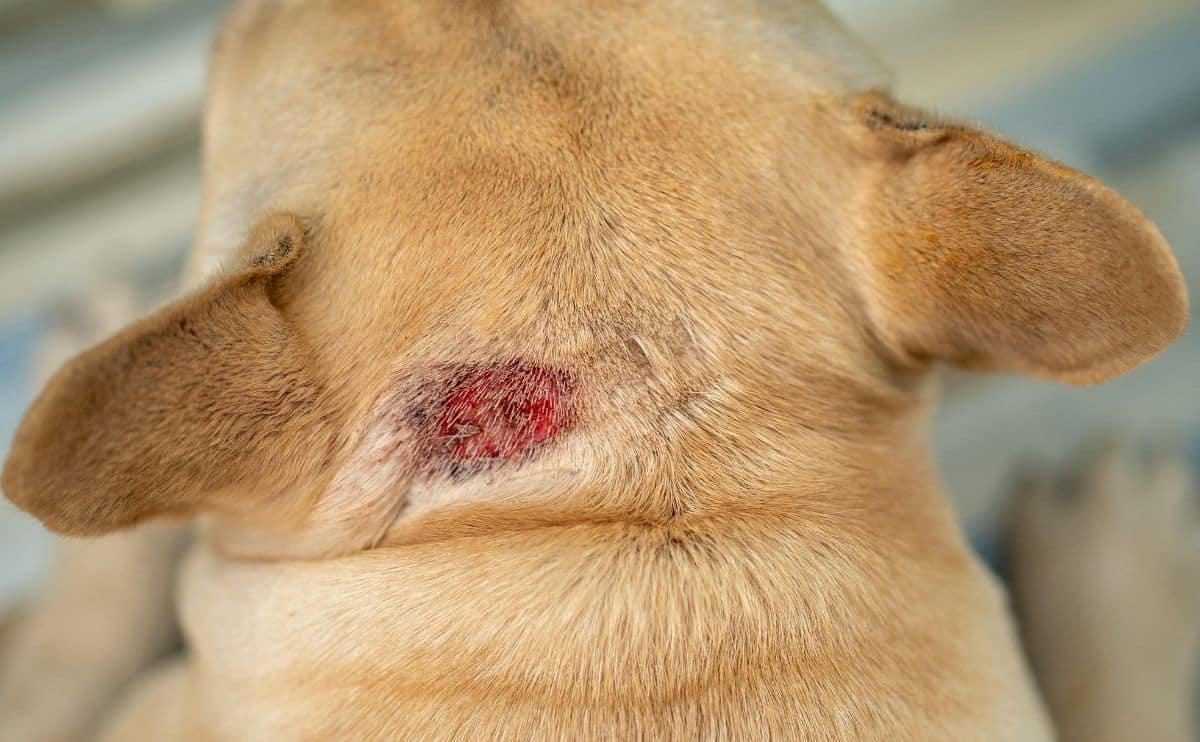Ringworm In Dogs: Signs, Treatment & More
When you purchase through links on our site, we may earn a commission. Here’s how it works.

Despite what its name implies, ringworm isn’t caused by a worm or other parasite that dogs can contract, like heartworms, tapeworms, etc. In fact, ringworm is a contagious fungal infection that’s common in nearly all domesticated animals, including dogs. We’ll help you know how to identify ringworm and what you should do if you suspect your dog has it.
Table of Contents
What Is Ringworm?
Ringworm, also called dermatophytes, is a group of fungi that causes infection in the outermost layer of the skin and can also live in hair follicles and sometimes in a dog’s nails. The infection is called ringworm because of the raised, round ring that appears in humans with ringworm infections.
In dogs, however, it’s frequently not ring-shaped. The most common fungal species that cause ringworm infections in dogs are Microsporum canis, Microsporum gypseum, and Trichophyton mentagrophytes.
How Do Dogs Get Ringworm?
Ringworm spreads easily by direct contact with an infected animal or person or by touching contaminated objects, like food bowls, bedding, a brush, and even contaminated surfaces in your home like furniture or carpeting. But be aware that the fungal spores in your home can cause infection for up to 18 months.
Ringworm infections aren’t life-threatening and typically only affect a few areas of the body. However, the infection can become more widespread in immunocompromised dogs, puppies, and senior dogs. It can take from 7-21 days for dogs exposed to ringworm to start showing signs of an infection.
Can You Get Ringworm From A Dog?
Yes, you can get ringworm from your pup. The three most common fungi that cause ringworm in dogs are zoonotic, meaning they can also infect humans. Ringworm spreads to humans just as it does between dogs — from direct contact with your pup or contact with anything that’s contaminated in your home.
Microsporum canis is the most common fungus responsible for ringworm in dogs and cats, meaning the infection can spread between the two species. While anyone can contract a ringworm infection, the young, elderly or people with a suppressed immune system are at an increased risk of catching ringworm from dogs.
Symptoms Of Ringworm In Dogs

Although ringworm infections aren’t a serious threat to your dog’s health, it’s important to know the signs so you can take action before it spreads to your other pets or family members. Common signs of ringworm in dogs include:
- Roughly circular areas of hair loss (but not always circular)
- Red, inflamed, or scabby skin
- Rough, brittle, broken claws (if nails are infected)
- Affected skin isn’t usually itchy
If left untreated, ringworm lesions become larger and irregular in shape, and the fungus spreads to other areas of the body. As lesions enlarge, the center of the lesions may begin to heal and regrow hair. If you notice any of these signs, it’s time to contact your veterinarian, who can confirm a ringworm infection.
What Does Ringworm Look Like On A Dog?
The following video shows you several photos of ringworm on various parts of dogs’ bodies to help you identify this pesky skin condition.
Ringworm Treatment For Dogs
If you’re wondering how to treat ringworm in dogs, it usually takes a three-pronged approach — giving your dog oral medication in conjunction with a topical treatment for at least six weeks (sometimes it can take much longer), as well as thoroughly disinfecting your environment.
In addition to prescribing your dog oral and topical medications, your vet may advise that you test and treat other animals in your home for ringworm, even if they’re not showing signs. Your vet also may want to retest your pup to make sure the infection has entirely cleared up.
Oral Medication
In most cases, your veterinarian will prescribe an oral ringworm medicine for dogs. The most widely prescribed antifungal drugs include Griseofulvin, Diflucan (itraconazole), and Lamisil (terbinafine). It’s important to continue giving your pup this medication until your vet gives you the okay to stop. Even if your pup appears to have healed, he could still be shedding the fungal spores.
Topical Treatment
In most cases of a ringworm infection, veterinarians recommend a topical therapy, like a medicated cream, ointment, or ringworm shampoo for dogs, to help treat and control the infection. This is in addition to oral medicine.
For the topical treatment to be the most effective, your vet may also recommend shaving your dog’s hair from the lesions and clipping all the fur on long-haired dogs to help prevent a spread. This helps to reduce the fungal spores living in the fur around the lesion and allows the topical medication to penetrate into the skin layers.
If your vet recommends bathing your dog with a medicated shampoo, you’ll need to do it at least twice weekly. Only use topical treatments recommended by your vet. Typically, you’ll need to use any topical treatment for at least six weeks or longer (similar to oral medication). But topical treatments can help decrease environmental contamination.
Environmental Cleaning
A crucial element of healing ringworm in dogs involves decontaminating your environment. In dogs, infected hair commonly breaks off, spreading the fungal spores around your home. Cleaning up the hair from floors, furniture, etc., is important but can be a challenge.
If you can keep your infected dog separated in a room, that makes containment easier. But because it takes six or more weeks to clear up an infection, this isn’t usually realistic. Daily vacuuming of carpet and furniture, mopping hardwood floors with a pet-safe disinfectant, and disinfecting bedding, bowls, etc., can help prevent the spread.
Are There Any Effective Home Remedies?
You’ll need veterinarian intervention to entirely clear up a ringworm infection, but there are some home remedies for ringworm in dogs that may help speed healing and ease your dog’s uncomfortable skin. But always check with your vet before you introduce at-home health care for your pup. Two popular holistic home remedies include:
- Apple cider vinegar: Pour a 50/50 apple cider vinegar solution and water into a spray bottle. Spray the infected lesions with the solution 2-3 times a day.
- Neem oil: Neem oil is thought to have many medicinal uses, including as an antifungal and to soothe irritated skin. You can apply a solution of 1% neem oil and 99% water using a cotton ball to the affected area up to 3 times per day.
A Word Of Caution
You may read on some sites that tea tree oil is helpful for ringworm in dogs. We recommend steering clear of using tea tree oil with dogs. Although it’s probably okay in extremely small amounts, even seven drops of tea tree oil can be extremely toxic for dogs.
Dog Hotspot vs Ringworm vs Other Skin Issues
Unfortunately, dogs can suffer from a wide variety of skin issues, and it can be hard for a pet owner to know what’s going on. Skin infections, such as pyoderma or hot spots can have a similar appearance to ringworm but require different treatment. The skin is usually very moist and itchy with hot spots, but with ringworm, the skin is typically dry and scabby without itching.
What’s more, other conditions can cause alopecia (hair loss) in dogs. Hair loss or inflamed skin could be a sign of dog allergies, a skin infection, or an underlying hormone condition, such as Cushing’s disease or hypothyroidism. We encourage you to consult with your vet to get to the bottom of your dog’s skin issues.




